Market research and a perusal of social media show that while one of the top five benefits consumers require in a shampoo is volume[1-2], many hair care users are unhappy with current volumising products because they fail to deliver long-term performance, essential care, and conditioning properties at the same time[3].
There is also growing demand among consumers for products specifically tailored to the needs of their own hair type[4].
Within the hair care industry, it is recognised that volume is a particularly challenging benefit to achieve because, to date, the standard approaches taken – fewer care ingredients or light conditioning polymers, addition of styling polymers or addition of silica or cellulose powders – are known to have a negative impact on sensory and care properties.
These approaches can also be complicated and time consuming because they require modifications to the carrier formulation.
Introducing polyquaternium-110
To respond to this unmet consumer need, in 2019, DSM launched a novel hyper-branched polymer, TILAMAR Boost 150 (polyquaternium-110), which was identified through a collaboration between DSM Materials Science Centre and DSM Personal Care & Aroma.
This hair care polymer has demonstrated significant volume boost combined with care benefits. Moreover, it can be added easily to existing shampoo formulations.
The polymer’s dual benefits are achieved due to a structural transformation during hair drying. Its mechanism of deposition, via coacervate formation, gives rise to lamellar structures that provide lubricant effects to ease wet combing. On drying these lamellar structures transform into hexagonal structures which provide the volume boost consumers desire.
Polyquaternium-110’s initial claimed benefits were substantiated by instrumental tests and confirmed by hairdresser assessments[5].
More recently, to address a growing consumer demand for bespoke hair care benefits, DSM carried out a new series of tests to assess the polymer’s volume and care performance on different hair types.
Different hair types have different needs
The benefits of improved and lasting volume are particularly sought after by Caucasian and Asian hair care consumers.
Studies on hair types according to ethnicity show that although the shape of a hair strand is not specific to any ethnic group, there are some broad tendencies.
Asian hair is generally straight, a round shape and low density. In contrast, Caucasian hair, whether straight or wavy, has a relatively elliptic shape and is characterised by high density[6-7]. It stands to reason therefore that a hair care product may produce different results in different hair types.
DSM’s instrumental hair test method
The instrumental test method followed, which involves before and after comparisons, was specially developed to provide hair care consumers with reassurance about the accuracy of results and tangible evidence about product performance.
Sample preparation
Hair swatches were washed either with a base shampoo (control) or a test formulation. Swatches were washed twice in succession using 0.5ml of shampoo per 3g of hair. Samples were combed five times to detangle the hair fibres and then dried overnight at 20°C and a relative humidity of 20%. After drying overnight, the swatches were placed in a climate room at 20°C and a relative humidity of 60%. Bulk volume measurements were then taken at different times.
Instrument
Hair volume was measured with a Bossa Nova Vision Bolero device. A camera took a succession of 36 pictures while each hair swatch was rotating 360°, back-illuminated by an LED-lamp. Software was then used to calculate the bulk volume, ‘frizz’ and total volume (bulk and frizz combined) of each hair swatch based on the difference between the light intensity transmitted (and grey level).
Results, expressed in cm3, reflected the calculated mean values of five hair swatches. They were then interpreted statistically using the ANOVA model with comparisons drawn according to the Dunnett and Tukey methods.
Various tests were performed using the above method:
i) Caucasian hair:
• comparison of the base shampoo and the base shampoo containing 2% Polyquaternium-110 as supplied;
• comparison of the base shampoo and the base shampoo containing 2% polyquaternium-110 as supplied and a conditioning polymer (0.25% PQ-7 active content);
• comparison of the base shampoo and the base shampoo containing 2% polyquaternium-110 as supplied with 1% PEG/PPG 4/12 dimethicone;
• comparison of a European market, volume shampoo with and without 2% polyquaternium-110 as supplied.
ii) Asian hair:
• comparison of an Asian market, volume shampoo with and without 3% polyquaternium-110 as supplied.
iii) Multiple hair types:
• Comparison of the base shampoo and the base shampoo containing 2% polyquaternium-110 as supplied and a conditioning polymer (0.25% PQ-7 active content) on four distinct hair types with different properties – virgin, straight, Asian hair; straight Caucasian hair (virgin and bleached); and virgin, curly Caucasian hair.
Study results demonstrate enhanced volume lasting 24 hours on different hair types:
i) Caucasian hair
As the graph in figure 1 shows, when 2% polyquaternium-110 was added to a base shampoo, volume performance increased by 196% for the first hour and by 32% after 24 hours.
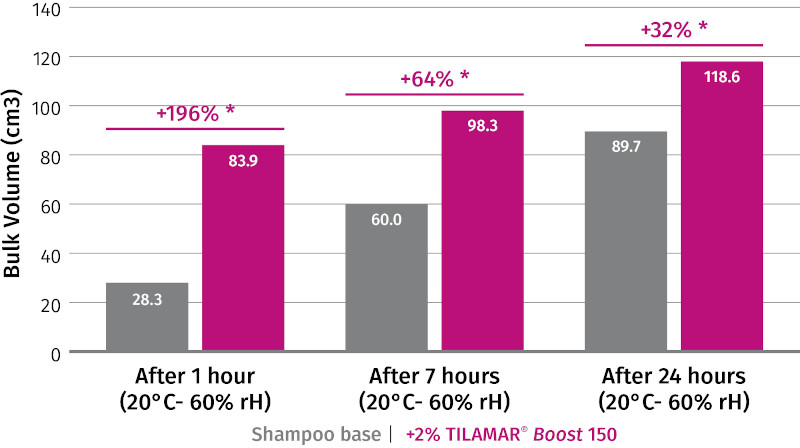
Figure 1: Comparison of volume performance of base shampoo on Caucasian hair, on its own (grey) and with the addition of 2% polyquaternium-110 (pink) over a 24-hour period from first use
Figure 2 illustrates these results in visually tangible terms.
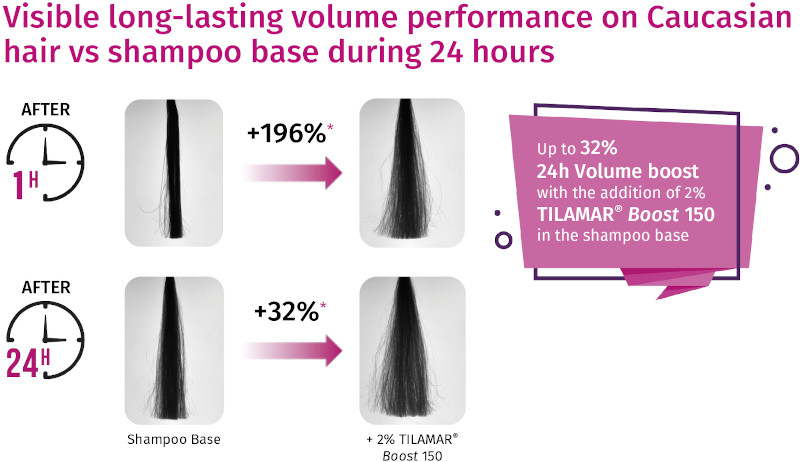
Figure 2: Photographic evidence of volume performance of polyquaternium-110 on Caucasian hair after 1 hour and 24 hours when used in a base shampoo at 2%
Enhanced volume was also evident when polyquaternium-110 was used in a shampoo base in combination with a conditioning polymer (0.25% PQ-7 active content).
Under these test conditions, volume performance increased by 213% after one hour and by 48% after 24 hours, suggesting that this is an optimal combination for long lasting volume performance.
The graph in figure 3 compares the volume performance of the base shampoo, the base shampoo with the addition of either a conditioning polymer or polyquaternium-110, and the base shampoo with the addition of both polymers.

Figure 3: comparison of volume performance of a base shampoo on its own and with the addition of a conditioning polymer or polyquaternium-110 or both
Adding 2% polyquaternium-110 to a European market volume shampoo was also found to increase the volume performance of the shampoo by 40% after 24 hours.
ii) Asian hair
Adding 3% polyquaternium-110 to an Asian market volume shampoo was found to improve volume performance by 20% after 24 hours. The images in figure 4, provide a visually tangible illustration.
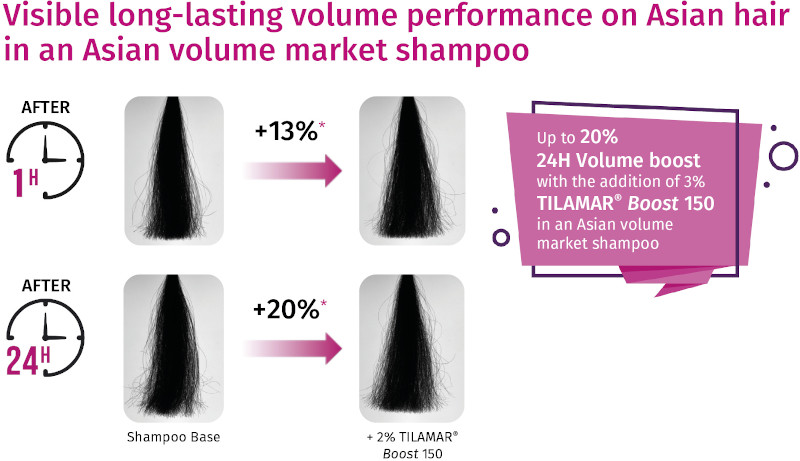
Figure 4: Photographic evidence of volume performance of polyquaternium-110 on Asian hair after 1 hour and 24 hours when added in an Asian market volume shampoo at 3%
iii) Multiple hair types
Instrumental tests also showed that when it was used at 2% in a formulation consisting of a conditioning polymer (0.25% PQ-7 active content) in the base shampoo, polyquaternium-110 increased volume in all four hair types studied. These results were still visible 24 hours from first use.
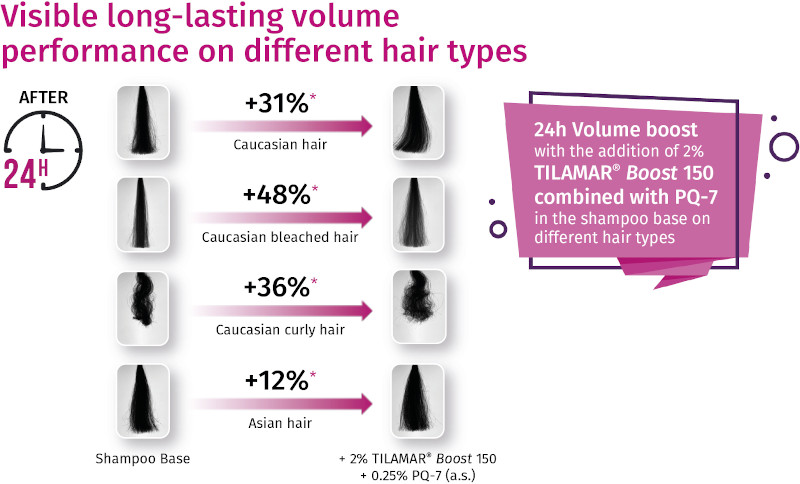
Figure 5: Photographic evidence of volume performance of 2% Polyquaternium-110 in the base shampoo combined with a conditioning polymer on four different hair types
Proven care properties
DSM’s original study found that on Caucasian hair, as well as visibly boosting volume performance, polyquaternium-110 increased the wet combing performance of a shampoo base (measured in terms of reduction in wet combing force) on its own and when combined with a conditioning polymer[5].
Now, subsequent tests, carried out according to the same methodology as the original (testing with INSTRON 5542; five hair swatches were tested per product at 20°C and 60-65% relative humidity; 15 measurements were made per hair swatch[5]), show that on Asian hair, polyquaternium-110 also enhances wet combing performance in an Asian market shampoo.
Indeed, as figure 6 illustrates, the polymer’s lamellar structure was shown to help decrease wet combing force by 48% compared with non-treated hair, which was more than twice the decrease measured in the original market shampoo (19%).
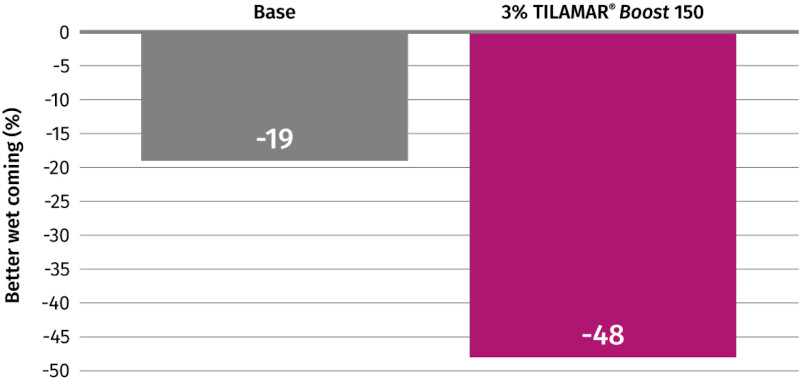
Figure 6: Comparison of the decrease in wet combing force on Asian hair vs non-treated hair, in an Asian market shampoo, with and without 3% polyquaternium-110
Polyquaternium-110 in existing & new formulations
Polyquaternium-110 can be added directly to formulators’ own shampoo bases and only one drop is needed. It is compatible with cationic, anionic and non-ionic ingredients and can be combined with current traditional conditioning polymers. The typical use level for this ingredient is 1–3%, with a dosage of 2% recommended for Caucasian hair and 3% for Asian hair.
DSM has developed a range of market-ready formulations that combine polyquaternium-110 with other ingredients in its portfolio, such as vitamins, moisturising actives and UV filters, to meet a wide range of hair care needs in addition to 24 hours of enhanced volume.
All formulations have been tested in line with the instrumental test method described above and their results proven. The range includes:
24-hour volume shampoo for grey and white hair
With age, the diameter of the hair shaft begins to shrink, making the hair thinner and more fragile. In addition, a decline in melanin can lead to grey, or white hair.
This formulation has been specially developed for hair that is becoming thinner with age, and for grey and white hair, and bleached blond hair in need of a volume boost with a touch of care.
It combines the volumising and care properties of polyquaternium-110 with vitamins, DSM’s UV filter, polysilicone-15, for UV protection and violet colourant to overcome hair yellowing.
In instrumental tests on Caucasian grey hair, this formulation was shown to increase volume by 29% for 24 hours and to improve wet combing performance by more than twice compared to a base formulation that did not contain polyquaternium-110.
Sulfate free, 24-hour volume shampoo
This formulation, infused with moisturising actives, boosts hair volume for up to 24 hours and also leaves it feeling perfectly cared for thanks to polyquaternium-110.
In instrumental tests on Caucasian bleached hair, it was found to increase volume by 36% for 24 hours and to improve wet combing performance by more than twice compared to a base sulfate free shampoo that did not contain polyquaternium-110.
Because the polymer has been proven to respect the vitality, diversity and balance of the scalp microbiome, this formulation also comes with the claim of including a microbiome-friendly ingredient.
Traceability & microbiome friendliness
Polyquaternium-110 has been proven to respect the vitality, diversity and balance of the scalp microbiome and certified as microbiome-friendly, according to My Microbiome Standard 19.10[8].
This certification provides additional reassurance to the growing number of consumers looking for ingredients that do not have an adverse effect on the balance of their scalp microbiome.
It also comes with clear information about its environmental impact and traceability.
In summary
Polyquaternium-110, was developed to satisfy an unmet need for increased hair volume (identified by market research as one of consumers’ top five desired benefits) while also retaining care and conditioning properties.
Its unique mechanism of deposition, via coacervate formation, involves transformation of a lamellar structure in wet hair to a hexagonal structure as the hair dries, creating volume.
It can be added directly to existing shampoo bases, adding value without the need for time-consuming and costly reformulations, and is also compatible with traditional conditioning polymers and silicone.
In instrumental and hairdresser tests, polyquaternium-110 had already been proven to deliver volume performance and increased hair elasticity and style ability.
New instrumental tests now confirm that polyquaternium-110’s proven benefits last for 24 hours and apply to multiple hair types.
The instrumental test method provides consumers with tangible and easy-to-understand evidence of performance.
Formulations including polyquaternium-110 could therefore help meet growing consumer demand for products that can deliver a range of bespoke hair care benefits alongside 24 hours of enhanced volume.
Authors
Melanie Waeckel, Global Marketing Manager Technical & Performance Ingredients, DSM, and Emmanuel Martin, Head of Application Hair Care, Research & Development, DSM
References
1. Based on 1922 internet users aged 18+ who use hair care products. Source: Lightspeed/Mintel, April 2018
2. Mintel In Europe. Benefits that women find most appealing in a hair care product (2018)
3. Consumer insights from DSM consumer insights hub, May 2020
4. Mintel study 2019 The Future of Haircare, Styling and colour:2019
5. Waeckel M, New hair care polymer uniquely combines volume and care benefits. sofw Journal 10-2019
6. Franbourg A, et al. Current research on ethnic hair. 2003; J Am Acad Dermatol. 48:115–126
7. Loussouarn G, et al. Diversity of hair growth profiles. Int J Dermatol. 2005; 44 (SUPPL. 1): 6–9.
8. https://www.mymicrobiome.info/mymicrobiome-standard-testing-products-microbiome-friendly.html

